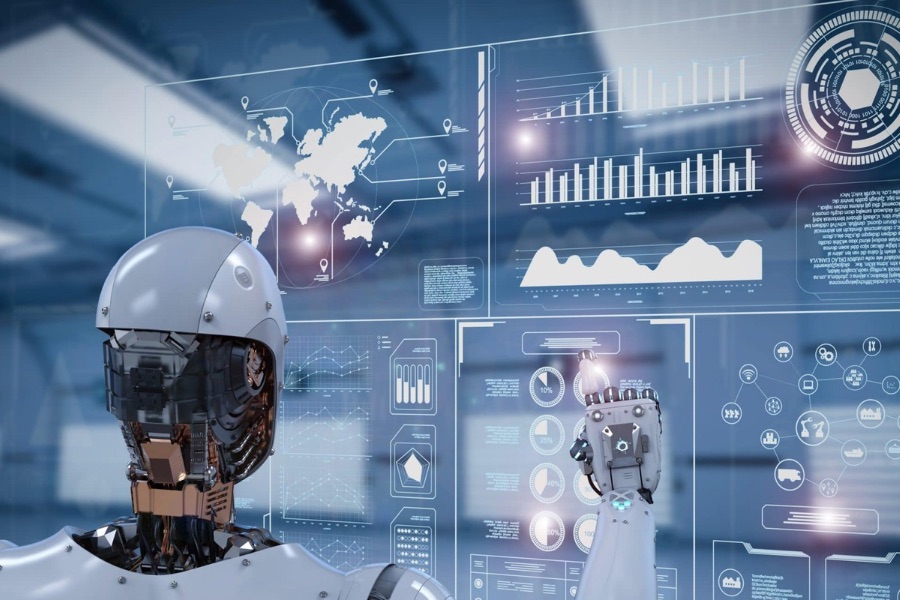What is Generative AI and What are the Generative AI Security Considerations?
July 17, 2024, 9 min read
Generative AI is a subset of artificial intelligence that focuses on producing new data similar to a given dataset. It leverages advanced algorithms to create text for sales, images, music, and code. With the ability to learn from large volumes of data, generative AI systems can mimic human creativity and expression complexities. The applications of generative AI are vast and varied, ranging from automated content generation in marketing and journalism to artistic endeavors such as AI-generated paintings and music compositions. These systems can simulate human-like creativity with remarkable accuracy, making them valuable tools in various industries.
The technology behind generative AI involves machine learning models, particularly deep learning architectures like Generative Adversarial Networks (GANs) and Variational Autoencoders (VAEs). These models can analyze patterns in existing data to generate new, creative outputs virtually indistinguishable from those produced by humans. For example, in text generation, models can produce coherent and contextually appropriate articles, scripts, or conversations, which are increasingly used in customer service and content creation.
Generative AI is also making significant strides in visual arts, where it powers applications that can create lifelike images from scratch or enhance existing ones. The fashion industry uses generative models to design clothing, while AI-generated characters and scenes are becoming more prevalent in entertainment. In music, generative AI can compose original pieces in various genres, pushing the boundaries of what is possible in creative arts.
With the proliferation of Generative AI, several Generative AI Security Considerations have emerged, necessitating a thoughtful approach to its deployment. As this technology becomes more integrated into our daily lives, addressing potential risks associated with data privacy, fairness, and security is crucial. These considerations are essential to ensure that the advancement of generative AI contributes positively to society without compromising ethical standards or personal privacy. The balance between innovation and responsibility will play a significant role in the future development and adoption of generative AI technologies.
Understanding Generative AI
Generative AI employs deep learning and neural networks to generate new content. These advanced systems are designed to learn from vast amounts of data, discern patterns, and produce highly realistic outputs.
The cornerstone of Generative AI lies in its ability to be trained on large datasets. Once trained, these models can create outputs strikingly similar to the input data. For instance, when trained on a database of images, Generative AI could produce entirely new yet highly realistic images that appear to be from the same dataset. The technology’s prowess doesn’t end there; it extends to generating text, music, and various other types of content, making it incredibly versatile.
The implications for text generation are significant. Applications range from developing chatbots that can engage more naturally with users to automating the content creation process for websites, articles, and reports. The key here is the ability of Generative AI to produce coherent, contextually relevant text based on the myriad patterns it has learned from the training data.
- Text Generation: Used in chatbots, content creation, and more. These systems can generate coherent paragraphs, craft summaries, and even create personalized content, making interactions more engaging and efficient.
- Image Generation: Techniques like GANs (Generative Adversarial Networks) create realistic images. These models pit two neural networks against each other – one generating images and the other evaluating them – to innovate and refine the process until the produced images are almost indistinguishable from real ones.
- Music and Art: AI-generated art and music are gaining popularity. By analyzing existing art or musical compositions, Generative AI can create new pieces that maintain the original style while introducing unique elements. This capability opens new avenues for creativity in fields traditionally dominated by human intuition.
Generative AI’s capabilities are not merely limited to simple replications or variations. Researchers and developers continually push the boundaries to create more sophisticated models to perform nuanced tasks. For instance, in image generation, GANs have made strides in producing high-resolution images that can be used for various design and development purposes. This level of detail and realism was unattainable with earlier methods.
Moreover, as Generative AI understands the intricacies of language structure and syntax, its applications in text generation evolve. Advanced models such as GPT-3 demonstrate the ability to converse fluidly with humans, generating responses that often sound natural and well-informed. This makes them invaluable tools for customer service, mental health support, and more.
The burgeoning field of AI-generated music and art represents another exciting frontier. Some platforms now enable users to compose music or create visual art pieces with minimal input, relying on Generative AI to handle the complexities of composition and design. These creative tools are not only accessible but also push the envelope of what can be achieved with the interplay of human creativity and machine learning.
Benefits of Generative AI
Generative AI offers numerous advantages across various domains:
- Efficiency: Generative AI automates tedious tasks and accelerates content creation. By leveraging advanced machine learning algorithms, Generative AI can handle repetitive and time-consuming tasks much faster than human workers, allowing businesses to allocate their human resources to more strategic and creative roles. For example, in content creation, an AI can quickly draft articles, scripts, and reports, reducing the time needed for human review and editing.
- Creativity: Inspires new ideas in fields like art and music. Generative AI can analyze massive datasets of artworks, musical compositions, and literature to understand different styles and genres. This enables the AI to create new pieces that can inspire human artists, musicians, and writers, fostering innovation. For instance, AI-generated music has been used to create background scores for films and video games, while AI-generated art is exhibited in galleries worldwide.
- Customization: Provides personalized experiences for users. By learning user preferences and behaviors, Generative AI can tailor content, advertisements, and product recommendations to individual users. This personalization improves user engagement and satisfaction. For example, in e-commerce, AI can generate customized shopping experiences by recommending products based on past purchases and browsing history. At the same time, AI can create personalized ad campaigns in digital marketing that resonate with specific target audiences.
Moreover, in customer service, Generative AI-powered chatbots can give instantaneous responses and resolve issues efficiently, enhancing the overall customer experience. These AI-driven systems can understand and replicate human-like interactions, making them reliable for 24/7 customer support. As a result, businesses can maintain a high level of service without incurring the costs associated with a large customer service team.
In healthcare, Generative AI holds the potential to revolutionize personalized medicine. AI can suggest personalized treatment plans and predict potential health issues by analyzing individual patient data. Furthermore, in drug discovery, AI can generate new molecular structures, speeding up the development of new medications and treatments.
In the entertainment industry, Generative AI is utilized to create immersive experiences. AI-generated characters and scenes in video games or movies can interact with users in previously impossible ways. This not only enhances the user experience but also opens up new creative possibilities for filmmakers and game developers.
Generative AI is a subset of artificial intelligence that focuses on producing new data that is similar to a given dataset. It leverages advanced algorithms to create text, images, music, and code. With the proliferation of Generative AI, several Generative AI Security Considerations have emerged, necessitating a thoughtful approach to its deployment.
Understanding Generative AI
Generative AI employs techniques such as deep learning and neural networks to generate new content. These systems can learn from vast amounts of data, discern patterns, and produce highly realistic outputs.
- Text Generation: Used in chatbots, content creation, and more.
- Image Generation: Techniques like GANs (Generative Adversarial Networks) create realistic images.
- Music and Art: AI-generated art and music are gaining popularity.
Benefits of Generative AI
Generative AI offers numerous advantages across various domains:
- Efficiency: Automates tedious tasks and accelerates content creation.
- Creativity: Inspires new ideas in fields like art and music.
- Customization: Provides personalized experiences for users.
Generative AI Security Considerations
While Generative AI offers substantial benefits, AI also brings critical security challenges. Here are some key Generative AI Security Considerations:
- Data Privacy: Ensuring that the AI respects and protects user data is paramount. This involves adoption of best practices such as data anonymization and strict access controls. Data privacy regulations like GDPR also demand rigorous compliance to safeguard sensitive information.
- Bias and Fairness: Avoiding algorithmic bias that could lead to unfair treatments or outputs. Continuous monitoring and updating of AI models are essential to mitigate any bias. Techniques like bias detection and fairness-aware algorithms can help in reducing unintended consequences.
- Misuse: Preventing the creation of malicious content, such as deepfakes or harmful misinformation. Security protocols should be in place to detect and prevent misuse. Organizations must leverage both technical and policy-based measures to discourage malicious applications.
- Accountability: Establishing clear guidelines on who is responsible for AI-generated content. This includes defining roles and responsibilities for stakeholders involved in the creation and deployment of AI models. Legal frameworks may also be needed to delineate accountability.
Data Privacy in Generative AI focuses on preventing unauthorized access to personal information. Organizations can employ encryption techniques and secure data storage solutions to achieve this. Moreover, transparency with users regarding data usage policies builds trust and ensures adherence to legal requirements. Employing data minimization principles, where only necessary information is collected and processed, can further enhance privacy.
Bias and fairness are central to ethical AI development. One primary method to combat bias is through diverse and inclusive training datasets that reflect a wide range of demographics and scenarios. Additionally, regular bias audits help identify and address any disparities in AI outputs. Collaborating with ethicists and social scientists can provide further insights into developing fair AI systems.
Preventing misuse is not just a technical challenge but also a societal one. Misuse detection mechanisms must be sophisticated enough to identify harmful outputs swiftly. Public awareness campaigns can educate users about the potential dangers of AI misuse. Setting up ethical review boards within organizations can offer additional oversight and governance, reducing the risk of AI being used unethically.
Accountability in Generative AI should be clearly defined through policy documents and legal agreements. This ensures that any issues related to AI-generated content can be traced back to responsible parties. Cross-functional teams involving legal, technical, and policy experts can develop comprehensive accountability frameworks. Regular updates and training on these frameworks ensure that all team members are aware of their responsibilities.
Mitigating Generative AI Risks
To address the aforementioned Generative AI Security Considerations, several strategies can be employed:
- Implement Robust Privacy Policies: Ensure compliance with data protection regulations. These policies should outline precise data collection, storage, and usage procedures. It’s crucial to protect sensitive data from unauthorized access and potential breaches.
- Regular Audits: Conduct frequent audits to check for biases and adjust algorithms accordingly. Continuous monitoring and evaluation help identify potential risks and ensure the algorithms meet ethical standards. Regular updates and recalibrations can also help the AI system evolve and improve over time.
- Transparency: Maintain transparency with users about how data is used and generated content’s creation. Users should be informed about the types of data being collected, the purposes for which it is used, and how AI-generated content is produced. This builds trust and encourages responsible use of AI.
- Clear Ethical Guidelines: Develop and adhere to strong ethical guidelines for AI deployment. Establishing a framework for ethical AI usage involves outlining the responsibilities of developers and users, promoting fairness, and preventing misuse. Guidelines should cover all aspects of AI deployment from design to application.
Moreover, implementing robust privacy policies involves not only compliance with existing laws but also anticipating future regulatory changes. IoT devices and AI-based tools include vast amounts of privacy risks. Privacy policies should be dynamic documents that evolve with technological advancements and emerging security threats. Building robust privacy frameworks requires collaboration between legal teams, data scientists, and cybersecurity experts.
Regular audits are essential for maintaining the integrity of Generative AI systems. Audits should be comprehensive, covering not just algorithmic performance but also the underlying data sets. By reviewing data for biases and ensuring that algorithms don’t perpetuate or amplify these biases, organizations can develop fairer and more responsible AI systems.
Transparency isn’t merely about divulging practices but also involves establishing clear communication channels with users. Regular updates on how data is being used, along with straightforward privacy notices and consent forms, can help in demystifying AI processes for the average user. Active efforts to engage with users can also foster a culture of accountability and trust.
Developing clear ethical guidelines is a proactive measure that addresses multiple facets of AI risk in any business. Ethical guidelines should be ingrained in the organizational culture and reflected in every step of the AI development lifecycle. Training programs and workshops can help educate employees and stakeholders on the importance of ethical AI utilization.




























